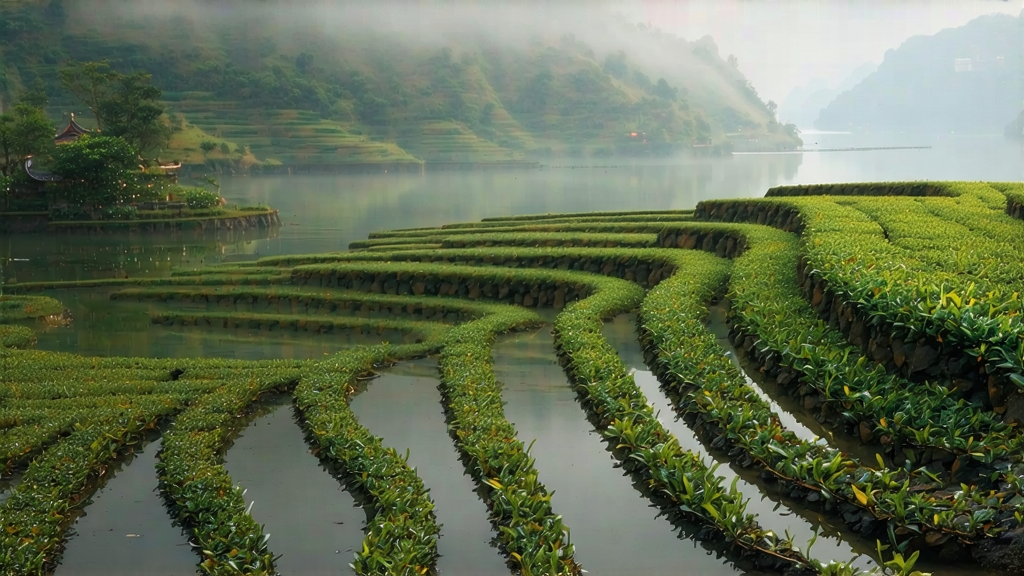
Biluochun, whose name literally means “Green Snail Spring,” is one of China’s ten most celebrated teas, yet it remains a delicate secret outside the circles of serious connoisseurs. Grown in the microclimate of Dongting Mountain, an island-hill complex that rises from the northeastern corner of Lake Tai in Jiangsu Province, this tea carries the breeze, mist, and floral air of an ancient Chinese garden in every pellet-sized curl. To understand Biluochun is to listen to a soft-spoken poem composed by monks, emperors, artisans, and the lake itself across one thousand years.
Historical whispers place the birth of Biluochun during the late Tang dynasty, when tea was shifting from compressed bricks to loose leaf. Local legend credits a nun named Bilu who wandered the mountain’s cloud-veiled paths, gathering wild shoots to brew for meditative clarity. Villagers, noticing the spirals she rolled by hand, nicknamed the tea “Xia Sha Ren Xiang” (“Startling Fragrance”) because its aroma drifted so far that it interrupted farm work. In the Qing Kangxi era (1662-1722) the emperor, touring the Yangtze Delta, sampled the tea and found its perfume “delicately murderous to the senses.” He renamed it Biluochun, combining the nun’s name with the snail-like shape of the finished leaf. Court annals record that four liang (150 g) of the finest grade once equaled the price of a Suzhou silk robe, establishing its reputation as the “Emperor’s Green.”
Strictly speaking, only leaf plucked within the 12-square-kilometer core zone of Dongting Dongshan (East Mountain) and Xishan (West Mountain) may claim the protected geographical indication of “Original Biluochun.” Yet the cultivar has traveled, spawning offshoot gardens in Zhejiang, Sichuan, and Guizhou. Purists classify these as “Taihu Type” (authentic) and “Non-Taihu Type,” differentiated less by genetics than by terroir. The Taihu microclimate marries subtropical humidity with lake-cooled nights, yielding bushes that bud ten days earlier than neighboring regions and accumulate an uncommon ratio of dimethyl sulfide, the compound responsible for Biluochun’s signature fruity-floral top note often likened to ripe peach, freesia, and fresh lychee.
Plucking begins when the overnight temperature climbs above 8 °C and two and a half leaves have unfurled—a window lasting barely fifteen days in late March. Pickers, usually women whose fingers are said to “know the heartbeat of the sprout,” break each shoot at the internode where the stem changes from mahogany to jade, ensuring the ideal sugar-to-polyphenol balance. A full day’s harvest fills only a shallow bamboo tray weighing 500 g; 60,000 such shoots will shrink to 100 g of finished tea.
Withering is skipped; instead, the leaves are immediately “kill-green” in a cast-iron wok heated to 180 °C. The master’s palm hovers two centimeters above the metal—when the hairs on his skin curl, the temperature is right. In a ballet lasting four minutes, he tosses, presses, and rolls the leaves, deactivating oxidative enzymes while preserving the downy white tips. The most critical phase is the spiral-shaping: the tea is dropped to 70 °C, and using only the fleshy pads of his fingers, the artisan coaxes each bud into a tight whorl that locks in fragrance. One circle per second, 600 rotations per batch, no broken edges—perfection is measured in silence, for the leaf must not whisper against the iron. When the curls feel “like sleeping silkworms,” they are given a final 50 °C “foot-dry” to reach 6 % moisture, then cooled on linen sheets scented with fresh orange blossoms, a local trick that rounds the tea’s acidity.
To brew Biluochun properly is to court subtlety. Begin with a tall, thin glass—not gaiwan—so the spirals can be observed unfurling vertically, a performance known as “clouds rising in spring sky.” Use 3 g for 150 ml of water at 75 °C; hotter temperatures extract the bitterness of catechins before the aromatics dissolve. First infusion: 45 seconds, no lid, allowing volatile esters to escape rather than condense on a cover. Second infusion: 25 seconds, when the leaf has relaxed and the cup delivers a broth